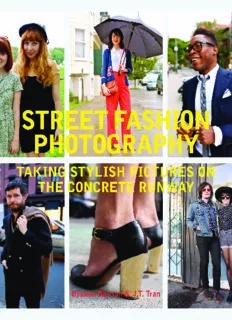
Street Fashion Photography: Taking Stylish Pictures on the Concrete Runway PDF
Preview Street Fashion Photography: Taking Stylish Pictures on the Concrete Runway
STREET FASHION PHOTOGRAPHY TAKING STYLISH PICTURES ON THE CONCRETE RUNWAY Dyanna Dawson and J.T. Tran Copyright © 2013 by Dyanna Dawson and J.T. Tran. All rights reserved. No part of this book may be reproduced in any form without written permission from the publisher. Library of Congress Cataloging-in-Publication Data available. ISBN: 978-1-4521-1537-5 Designed by River Jukes-Hudson Chronicle Books LLC 680 Second Street San Francisco, California 94107 www.chroniclebooks.com THE NUTS AND BOLTS OF PHOTOGRAPHY Street style photography is an enjoyable and rewarding field. All it takes is a camera and some motivation. If you absorb the knowl- edge in this book and apply it well, you’ll be taking stunning pho- tos before you know it. Let’s get started, shall we? CAMERAS So we’ve established that you will need a camera. To help you fig- ure out which camera is best for you, we’re going to break it down to basics. There are countless brands and varieties on the market, in addition to a plethora of camera lenses, flash units, and other accessories. With so many options, selecting the right camera at the right price point for you can feel overwhelming. Don’t worry, we’ve got it covered. (If you want even more detail, cnet.com is an excellent source of information.) Think about what you are able and willing to carry on your person every day. An important part of being a street style pho- tographer is being able to capture the subjects around you at a moment’s notice—especially if you plan to take candid shots. You’ve got to have a camera with you at all times, because you never know when you’ll cross paths with someone fabulous. Understandably, larger cameras with multiple lenses are rather 7 burdensome and inhibiting to carry with you at all times, so you may want to find a compromise. Fortunately, technology is advancing rapidly, and there are many smaller, lightweight cam- eras that produce excellent results. There are several things for you to consider when you are selecting a camera, including price range, purpose, and size. 1. Price range. How much would you like to spend on the camera? This will determine which cameras are available to you. It is not nec- essary to spend an enormous amount on your first camera, but you should keep in mind that the price of a camera and equipment often dictates its level of quality components and design. As the saying goes: You get what you pay for. 2. Purpose. You’re going to be using your camera for street style photography, obviously! Thinking about how you’ll use it will narrow down your choices. Where do you plan to go? Will you be photographing during the day or at night or both? Will you be in crowded areas? Do you intend to use the camera for other pur- poses as well? 3. Size. “The best camera is the one you have with you.” Street style photography will require you to lug the camera around with you as much as possible, and for long hours. A heavy or cumbersome camera and accessories may not be the best choice to carry on your person all day, every day. Skinny jeans have enjoyed enormous popularity in the last decade or so, making a lady in wide-leg trousers or bell-bottoms a beautiful rarity. 9 Of these three considerations, the very first question to ask your- self is “What is my price range?” Cameras and photography equipment can be very expensive, so once you determine the amount you are willing to initially invest, you can start to research options in your price range. We’ll explore the different options in this section. Category 1 – Point and Shoot In the $100 and under bracket, you will likely be limited to point- and-shoot compact cameras. Point-and-shoot cameras are the starting point and what most people seem to have already. They are affordable, light and compact, and easy to use. A few of the more expensive models can produce some surprisingly high- quality images. Even if you are willing to invest a lot of money in a high-end “prosumer” camera—perhaps you should learn to drive a Camry before you roll off the lot in a Ferrari. One word of warn- ing about point-and-shoot cameras is that technology is advanc- ing faster and faster, and the gap between cell phone cameras and point-and-shoot cameras narrows every day. Like any elec- tronics, the lowest priced items are usually the older models and thus the first to become obsolete. These are very similar to what you probably already have on your cell phone, but include advanced features and a marked increase in image quality. They are named for their ease of use; one simply points the camera and presses the shutter button. This is the type of camera with which we started our own blog, theSFStyle.com. There’s nothing wrong with these cameras. They will limit overall photo quality and the lighting situations you will be able to photograph in, but if you’re just starting out, these cameras force you to develop your skills. After you’ve gotten used to composing a good shot and spotting the right time and place 10
Description: